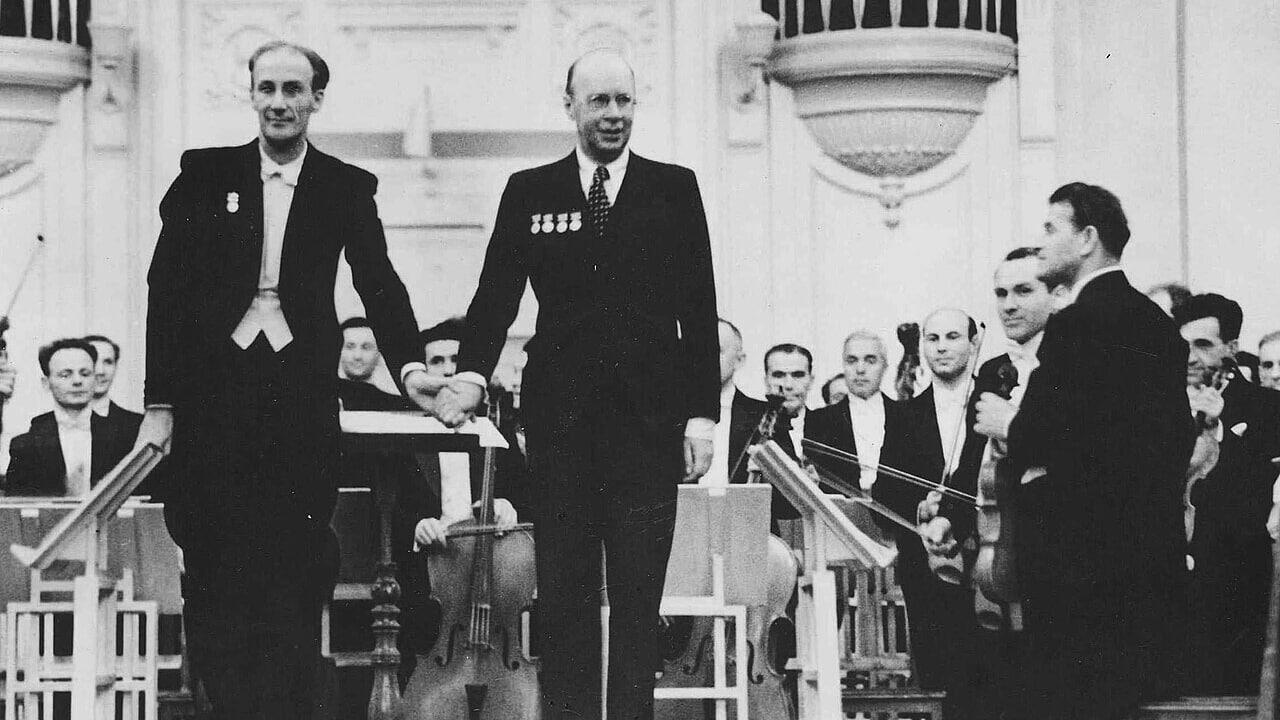If the popular Stalin Prize-winning Fifth Symphony of Sergei Prokofiev, composed in 1944, delivers triumph, heroism and emotional catharsis, the Sixth, by comparison, is shadowy, austere, and enigmatic. It reveals itself fully after repeated attentive listenings.
Arriving at the height of post-war Soviet Stalinism, Symphony No. 6 in E-flat minor, Op. 111 was initially well received when Evgeny Mravinsky led its premiere in Leningrad on October 11, 1947. A month later, when the Symphony was performed in Moscow, the political climate shifted. Prokofiev was branded a “decadent formalist” by the Congress of Composers, Stalin’s artist censors led by Andrei Zhdanov. For the remaining six years of his life, Prokofiev, his health failing, did not fully recover from the attack.
Pressured to explain the tragic nature of the work, Prokofiev offered a cryptic reference to the Great Patriotic War:
Now we are rejoicing in our great victory, but each of us has wounds that cannot be healed…One has lost those dear to him; another has lost his health. These must not be forgotten.
Shortly after completing the work, he provided the additional brief summary:
The first movement is of an agitated character, at times lyrical, at times austere; the second movement, Largo, is brighter and more songful; the finale, rapid and in a major key, is close in character to my Fifth Symphony, save for reminders of the austere passages in the first movement.
Prokofiev briefly considered dedicating the Symphony to the memory of Beethoven. Perhaps not coincidentally, it is cataloged with the same opus number as Beethoven’s final piano sonata.
The Sixth Symphony is set in three movements rather than the traditional four. The first movement (Allegro moderato) begins with a single fragmented statement in the brass which mockingly suggests a military march. This opens the door to the gloomy, wandering first theme, introduced by the strings. Unfolding in a continuously rolling 6/8 meter, the theme is hauntingly sing-songy and incessantly inescapable. A shrieking clarinet and low, growling trumpets are not far from the world of Mahler.
The second movement (Largo) begins with a terrifying, anguished eruption. Amid the titanic sonic power, there are vague echoes of Wagner’s Parsifal. The second theme offers a shimmering respite, with a lushly beautiful melody reminiscent of the “love theme” from Prokofiev’s 1936 ballet Romeo and Juliet. In the final moments, gloomy muted trumpets and a wistful statement by the oboe give way to the celestial sounds of the harp and celesta.
Fun and frivolity burst forth in the opening of the final movement (Vivace) with a fiddle tune reminiscent of a wildly jubilant Russian folk dance. As with so much of this Symphony, something mocking and sardonic seems to be lurking just beneath the surface. As the movement continues, the second theme from the first movement reappears. With the arrival of the coda, the dizzying motion evaporates into the shadows of the low woodwinds. We are again confronted with gloom and terror. A ghostly outline of the wild dance returns in the bass to sweep us into the final bars. A sudden resolution in E-flat major feels more sinister than reassuring.
Five Great Recordings
- Prokofiev: Symphony No. 6 in E-flat minor, Op. 111, Neeme Järvi, Scottish National Orchestra Chandos
- Valery Gergiev and the Mariinsky Theatre Orchestra (2016 concert)
- Evgeny Mravinsky and the Leningrad Philharmonic Orchestra (1967 recording)
- Eugene Ormandy and the Philadelphia Orchestra (1961 recording)
- Franz Welser-Möst and the Cleveland Orchestra (2024 recording)
Featured Image: Yevgeny Mravinsky and Prokofiev taking a bow after the second performance of the Sixth Symphony on October 12, 1947


Mr. Judd, Prokofiev’s Sixth Symphony is a favorite of mine; thanks so much for your article. Indeed, I’ve got the Neeme Järvi CDs featured here. Certainly Järvi’s recording is well-known, but it strikes me as uninspired and rather lacking in coherence.
Eugene Ormandy’s recording from 1950 (mono) is surely a far better performance. Yes, you list Ormandy’s 1961 record (stereo), but did you know that the one from 1950 is evidently the Symphony’s premiere recording? Both Ormandy and orchestra give the work its proper due, one that’s substantially different from the 1961 recording. Hear it here:
https://youtu.be/bT07h7yJQN4?si=zzzCzmFvCfZKa3lY
Thanks again!